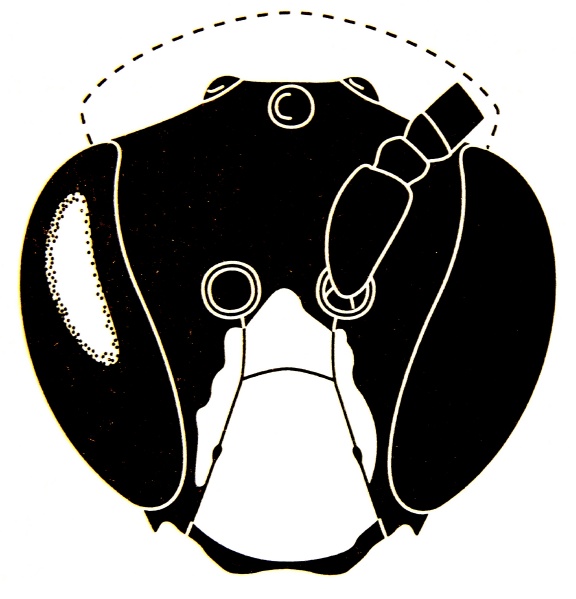Hylaeus in Hawaii

Hylaeus in Hawaii |

|
Hylaeus difficilisIslands: Molokai, Lanai, Maui, HawaiiLocations: Molokai - (Kamakou Rd., Puu Kolekole) Lanai - (Lihua, Munro Trail) Maui - (Halemauu Trail, Hanaula, Hosmers Grove, Kahoma, Kalepeomoa, Kilohana Pali, Kipahulu Valley, Koolau Gap, Laie Flats, Lauulu Trail, Oili Puu, Puu Keokea, Puu Kukui, Sliding Sands Trail, Waikamoi Preserve) Hawaii - (Ahumoa, Bryon's Ledge, Crater Rim Trail, Devestation Trail, HAVO observatory, Hilina Pali Rd., Hilton Waikaloa, Kaalualu, KAHO, Kaloko NHP, Ke Kailani, Keahole Point, Keanakakoi, Keawaiki, KFU, Kilauea Crater, Kipuka Alala, Kipuka Kalawamana, Kamilo, Kalualu, Kapapala, Kaupulehu Dunes, Kiholo Dunes, Kipuka Ki, Kipuka Maunaiu, Kipuka Nene, Kipuka Puaulu, Kohanaiki, Kona Coast SP, Kua Bay, Kualana, Kukio, Lae o Milo, Luahinewai, Mahana, Makaopuhi Crater, Mauna Iki, Mauna Kea, Mauna Loa Rd., Mauna Loa Summit, Naulu Trail, Ocean View Estates, Old Kona Airport, Ooma, PTA, Puu Huluhulu, Puu Waawaa, Saddle Rd., South Point, Volcano) Habitats: Lowland and montane dry shrubland and dry to wet forest, and at the coast Plants: Acacia, Argyroxiphium, Bidens, Chamaesyce, Cheirodendron, Dodonaea, Dubautia, Geranium, Lipochaeta, Metrosideros, Myoporum, Rhamnus, Santalum, Sapindus, Scaevola, Schinus, Sida, Sophora, Styphelia, Tetramolopium, Tournefortia, Vaccinium Xerces: No info. Insects of Hawaii: Medium-sized bees with clear to smoky wings. Male face usually with oval yellow mark or mark on clypeus only, hemistemites of S7 broadly triangular or with a short process, process of S8 not dilated and apex simple or with very short bifurcations, gonoforceps subequal to penis valves. Female unmarked, hair ofscutum long, of T6 mediurnlength and prostrate. Sister species of H. laetus. Hylaeus difficilis (Maui Nui and Hawaii) and H. laetus (Kauai to Hawaii) are broadly sympatric sister species that are closely similar in sculpture. Each species has variable yellow markings such that some specimens in each may be similar in appearance. In his key, Perkins (1910:602) distinguished the males on the basis of the apex of the median process of S8 (longish bifurcation in H. laetus, not so in H. difficilis; but sometimes H. difficilis may have a moderately long bifurcation) and the pubescence on the mesonotum (rather long in H. difficilis; short in H. laetus). Both species have a similarly marked face, including the clypeus, lower paraocular areas, and supraclypeal area in one large yellow mark or only the clypeus. Hylaeus laetus may or may not have an apical yellow spot on the prothoracic lobes and usually has basal stripes on the tibiae, up to half the length of the hind tibia, and yellow basitarsi. Hylaeus difficilis almost never has a spot on the lobes and usually has less yellow markings on the legs or none, but some specimens of H. difficilis may have similar leg marks. Coastal specimens from Hawaii may have marks on the prothoracic collar and lobes, as well as extensive marks on the legs. Hylaeus difficilis has the lateral process of S7 shorter, the apex narrow, and of a sclerotized brown color. In H. laetus, the lateral process is broad, translucent apically, and longer than the width of the hemisternite. Females can be separated by the shorter scutum hair of H. laetus. In more montane areas H. difficilis may occur with H. volcanicus and H. nivicola, both of which have longer malar spaces. Males can also usually be told from the former species by the simple process of S8; while it may be prolonged into bifurcations that can be moderately long, those of H. volcanicus are always much longer. Females can be more difficult to separate, as the malar space of H. volcanicus is variable. The smaller bee H. coniceps also can be found with them. The males are distinctive, but the females are similar to H. difficilis and may be distinguished from that species by the smaller malar area and the longer, erect, black hairs of T6. Insects of Hawaii Volume 17 
UH/DOD: Hylaeus near military lands 
Other: On telling apart difficilis and anthracinus: Coastal and lowland populations of H. difficilis often have males with wider lateral face marks than normal, resembling H. anthracinus, but these usually also have yellow marks on the legs. H. anthracinus may sometimes have narrower lateral marks like H. difficilis but is always all-black except for the face. |

|